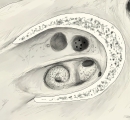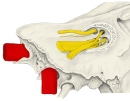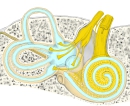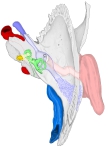


 |

|
 |
 |
| 右内耳道底 |
内耳道底と神経 |
左側頭骨(内側面) |
右耳(前面) |
 |
|
|
|
| 右側頭骨(上面)
|
聴覚・模型図 |
|
|
「 船戸和弥のHP 」では以下のように解説している。
「内耳道は顔面神経、中間神経、内耳神経および迷路動静脈の通路である。その奥行きの行き止まりになったところ、すなわち内耳道底は横稜によって上下に分かれ、いずれにも多くの小孔がある。その上部前方のやや大きい孔が顔面神経管の起点で、その他の小孔は内耳神経の枝を通ずる。」
また、以下は「Wikipedia」の解説文となる。
The internal auditory meatus (also meatus acusticus internus, internal acoustic meatus, internal auditory canal, or internal acoustic canal) is a canal within the petrous part of the temporal bone of the skull between the posterior cranial fossa and the inner ear.
【 語 句 】
・petrous part of the temporal bone:側頭骨の錐体部 ・posterior cranial fossa:後頭蓋窩 ・inner ear:内耳
【Structure】
The opening to the meatus is called the porus acusticus internus or internal acoustic opening. It is located inside the posterior cranial fossa of the skull, near the center of the posterior surface of the petrous part of the temporal bone. The size varies considerably. Its outer margins are smooth and rounded.
The canal which comprises the internal auditory meatus is short (about 1 cm) and runs laterally into the bone.
The lateral (outer) aspect of the canal is known as the fundus. The fundus is subdivided by two thin crests of bone to form three separate canals, through which course the facial and vestibulocochlear nerve branches. The falciform crest first divides the meatus into superior and inferior sections; a vertical crest (Bill's bar, named by William F. House) then divides the upper passage into anterior and posterior sections. Although there are three osseous canals, the fundus is conceptually divided more commonly into four quadrant areas according to the four major nerve branches of the inner ear:
【 語 句 】
・internal acoustic opening:内耳孔 ・comprise:構成する ・fundus:底 ・vestibulocochlear nerve: ・falciform:鎌状の ・osseous:骨の ・conceptually:概念的に ・quadrant:四分円
- anterior superior - facial nerve area (contains facial nerve and nervus intermedius)
- anterior inferior - cochlear nerve area (contains cochlear nerve)
- posterior superior - superior vestibular area (contains superior division of vestibular nerve)
- posterior inferior - inferior vestibular area (contains inferior division of vestibular nerve)
The cochlear and vestibular branches of cranial nerve VIII separate according to this schema and terminate in the inner ear. The facial nerve continues traveling through the facial canal, eventually exiting the skull at the stylomastoid foramen.
【Function】
The internal auditory meatus provides a passage through which the vestibulocochlear nerve (CN VIII), the facial nerve (CN VII), and the labyrinthine artery (an internal auditory branch of the anterior inferior cerebellar artery in 85% of people) can pass from inside the skull to structures of the inner ear and face. It also contains the vestibular ganglion.
【 語 句 】
・cochlear nerve:蝸牛神経 ・vestibular:前庭の ・cranial nerve:脳神経 ・schema:概要 ・facial canal:顔面神経 ・stylomastoid foramen:茎乳突孔 ・labyrinthine artery:迷路動脈 ・anterior inferior cerebellar artery:前下小脳動脈 ・vestibular ganglion:前庭神経節
■ 写真やイラストを掲載しているサイト ■
・ イラストや写真を掲載しているサイト-Ⅰ
・ イラストや写真を掲載しているサイト-Ⅱ
・ イラストや写真を掲載しているサイト-Ⅲ
・ イラストや写真を掲載しているサイト-Ⅳ
・ イラストや写真を掲載しているサイト-Ⅴ
